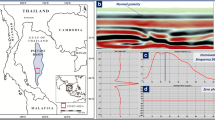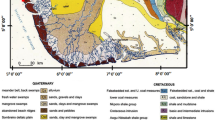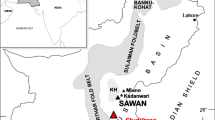Abstract
This study is sequentially constructed to develop an understanding of 3D seismic attributes working mechanism and algorithmic expressions used for finding key geomorphological features of fluvial system. The study consists of two study areas, Eromanga Basin Naccowlah Block of Australia and North Sea F3 Block Dutch sector. Seismic attributes (amplitude envelope, instantaneous frequency, cosine of phase, spectral decomposition and sweetness) were used to conduct qualitative and quantitative analysis. The geomorphological analysis helped to elucidate channel geometry and identification of lithology in channel course. The systematic methodology for the study was followed for both study areas, which consisted of the selection of desired seismic horizons, its flattening for analysis and application of attributes. With the purpose of understanding fluvial system features, 3D seismic give attributes significant information increment in the existing information. This addition can codicil geological information of the fluvial system, which can also help in investigating other paleo-geomorphic features.
Research highlights
-
3D seismic geomorphology analysis
-
Seismic attributes application
-
Validation of seismic attributes analysis
-
Fluvial system sinuosity estimations via 3d seismic









Similar content being viewed by others
References
Alqahtani F A, Jackson C A-L, Johnson H D and Som M R B 2017 Controls on the geometry and evolution of humid-tropical fluvial systems: Insights from 3D seismic geomorphological analysis of the Malay Basin, Sunda Shelf, southeast Asia; J. Sedim. Res. 87(1) 17–40, https://doi.org/10.2110/jsr.2016.88.
Azeem T, Yanchun W, Khalid P, Xueqing L, Yuan F and Lifang C 2016 An application of seismic attributes analysis for mapping of gas bearing sand zones in the Sawan gas field, Pakistan; Acta Geod. Geophys. 51(4) 723–744, https://doi.org/10.1007/s40328-015-0155-z.
Barnes A E 2016 Chapter 1: Overview of post-stack seismic attributes; Handbook of Poststack Seismic Attributes, https://doi.org/10.1190/1.9781560803324.ch1.
Brown A R 1996 Seismic attributes and their classification; Leading Edge 15(10) 1090, https://doi.org/10.1190/1.1437208.
Chopra S and Marfurt K 2006 Seismic attributes – A promising aid for geologic prediction; CSEG Recorder 2006 Special Edition, pp. 110–121.
Horacio 2014 River sinuosity index: Geomorphological characterisation; Technical Note 2.
Khan H A, Zouaghi T, Iftekhar S, Khan M J and Irfan M 2019 Plio-Pleistocene stratigraphic sequences and depositional model using 3D seismic interpretation constrained by well logs in Central Graben, North Sea; J. Earth Syst. Sci. 128(4) 1–19, https://doi.org/10.1007/s12040-019-1113-x.
Koson S, Chenrai P and Choowong M 2014 Seismic attributes and their applications in seismic geomorphology; Bull. Earth Sci. Thail. 6(1) 1–9.
Li Q, Yu S, Wu W, Tong L and Kang H 2017 Detection of a deep-water channel in 3D seismic data using the sweetness attribute and seismic geomorphology: A case study from the Taranaki Basin, New Zealand; NZ J. Geol. Geophys. 60(3) 199–208, https://doi.org/10.1080/00288306.2017.1307230.
Lin T, Zhang B, Guo S, Marfurt K, Oklahoma U, Wan Z and Guo Y 2013 Spectral decomposition of time- versus depth-migrated data; Conference: SEG Technical Program Expanded Abstracts 2013, Houston, TX USA, pp. 1384–1388, https://doi.org/10.1190/segam2013-1166.1.
Marfurt K J, Kirlin R L, Farmer S L and Bahorich M S 1998 3-D seismic attributes using a semblance-based coherency algorithm; Geophysics 63(4) 1150–1165, https://doi.org/10.1190/1.1444415.
Posamentier 2015 Seismic geomorphology – an overview; In: Seismic geomorphology: Applications to hydrocarbon exploration and production (eds) Davies R J, Posamentier H W, Wood L J and Cartwright J A, Geol. Soc. London, Spec. Publ. 277 1–14.
Radovich B J and Oliveros R B 1998 3-D sequence interpretation of seismic instantaneous attributes from the Gorgon Field; Leading Edge 17(9) 1286, https://doi.org/10.1190/1.1438125.
Sawyer D E, Flemings P B, Shipp R C and Winker C D 2007 Seismic geomorphology, lithology, and evolution of the late Pleistocene Mars-Ursa turbidite region, Mississippi Canyon area, northern Gulf of Mexico; Am. Assoc. Pet. Geol. Bull. 91(2) 215–234, https://doi.org/10.1306/08290605190.
Silva R M, Baroni L, Ferreira R S, Civitarese D, Szwarcman D and Brazil E V 2019 Netherlands Dataset: A New Public Dataset for Machine Learning in Seismic Interpretation, http://arxiv.org/abs/1904.00770.
Simpson C 2014 10 Reasons Why Geomorphology is Important; http://geomorphology.org.uk/sites/default/files/10_reasons_full.pdf.
Ulrych T, Sacchi M, Graul M and Taner M T 2007 Instantaneous attributes: The what and the how; Explor. Geophys. 38(4) 213–219, https://doi.org/10.1071/EG07023.
Wood L J and Mize-Spansky K L 2009 Quantitative seismic geomorphology of a Quaternary leveed-channel system, offshore eastern Trinidad and Tobago, northeastern South America; AAPG Bull. 93(1) 101–125, https://doi.org/10.1306/08140807094.
Acknowledgements
We are thankful to the Department of Resources, Queensland Government, for providing us open-source data. We are also thankful to Schlumberger Pakistan for providing state-of-the-art software support and grateful to the Department of Earth and Environmental Sciences, Bahria University, Karachi Campus, for letting us use their Digital Geophysical Data Lab for data interpretation.
Author information
Authors and Affiliations
Contributions
Haris Ahmed Khan: Supervised this research concept. Saifullah Abdul Qadir: Generated all the results and initially compiled the manuscript. Muhammad Jahangir Khan: Quality checking, reviewing and final compilation. Faraz Hasan Siddiqui: Industry mentor who provided software and scientific support. Mirza Saad Ahsan: Literature review and data collection and processing.
Corresponding author
Additional information
Communicated by George Mathew
Rights and permissions
About this article
Cite this article
Khan, H.A., Qadir, S.A., Khan, M.J. et al. Modelling of geomorphological features of fluvial systems in Eromanga Basin and North Sea using 3D seismic attributes. J Earth Syst Sci 132, 62 (2023). https://doi.org/10.1007/s12040-023-02076-3
Received:
Revised:
Accepted:
Published:
DOI: https://doi.org/10.1007/s12040-023-02076-3




